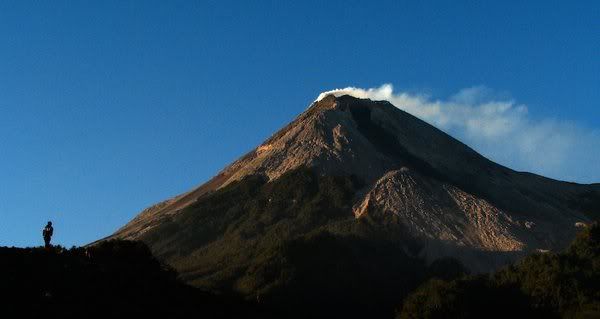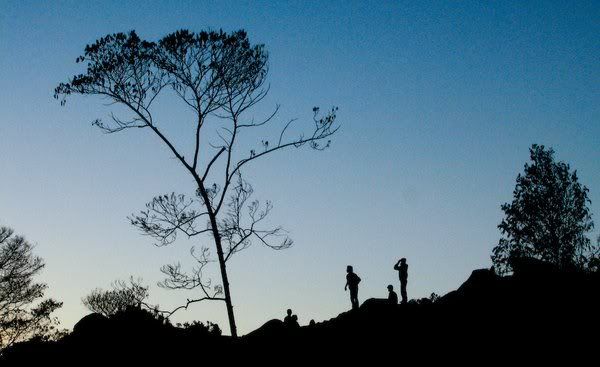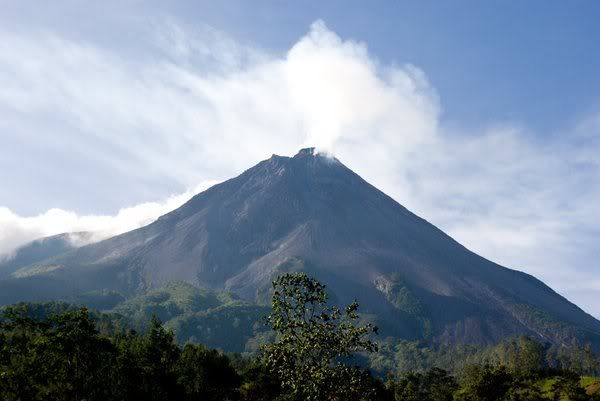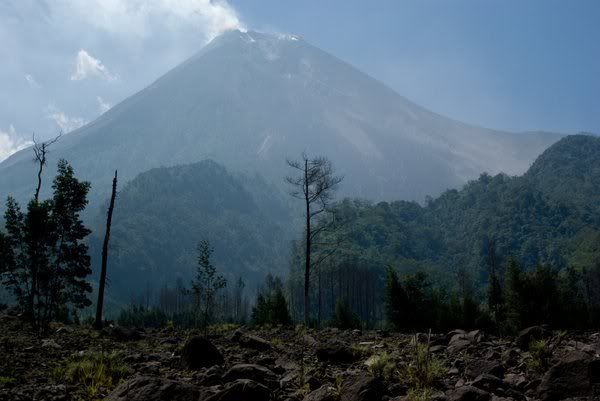Tomb of Imogiri
Situated on the slopes of the hills Imogiri, Bantul, Yogyakarta, The tomb Imogiri confirmed as social and political status of people who were buried in this place. Yes, the hill with 409 + of this ladder is devoted to the tomb of the king and the relatives of the Islamic Mataram Kingdom and their descendants. For the Javanese, the mountains or hills symbolize high status as well as an effort to get closer to the Almighty.The choice of the hill which is also named Pajimatan Girirejo has its own story. According to local stories, when Sultan Agung Hanyakrakusuma’m looking for a special burial ground as the sultan and the sultan’s family, he threw handfuls of sand from Arab lands. Sand landed in the hills Imogiri, so the place was chosen by Sultan Agung. In the year 1632 AD, Imogiri tomb complex was built by Sultan Agung to appoint an architect named Kyai Tumenggung Tjitrokoesoemo. Thirteen years later, at the tomb of Sultan Agung of this reason was buried after his death in 1645 AD
Sultan Agung himself known as the greatest ruler in the Islamic Mataram Kingdom. He was the third king after Penembahan Senopati and Penembahan Seda Krapyak. Sultan Agung has a big name for being able to control almost all the land of Java and also dared to attack the headquarters of the VOC in Batavia in 1628 and 1629 AD, although it always failed. The failure of this invasion also save the mysterious story of a traitor who is also buried in the Tomb Imogiri. He is Tumenggung Endranata, one courtier who had leaked the plan Mataram Sultan Agung to attack the Dutch.
Due to treacherous act, the mow-mow rice in preparation for the logistics on their way to Batavia was burned by the Dutch troops, so troops of Sultan Agung can be easily beaten back. Knowing one of his followers betrayed, Sultan Agung and then take decisive action to punish off Tumenggung Endranata. Head of the Tumenggung then decapitated, and the headless body was later planted in one of the steps below the gate of the tomb. The pilgrims will find a staircase made of stone which is the tomb extends these traitors. The stairs of stone grooved because many people have stepped on it. This monument is certainly a warning to followers of Sultan Agung to betrayal does not happen again.
Visiting the Tomb of Imogiri, tourists can experience the magical atmosphere straight from a sacred place by the majority of Javanese society. The smell of flowers and incense pushed around the tomb, because almost every day of the servants put the palace of the special offerings at the tombs of kings. In fact, according to one of his caretaker, the tomb of Sultan Agung until now always fragrant because he is considered to have reached levels of Wali Allah (lover of God).
Besides the tomb of Sultan Agung, the place is also buried 23 king descendant of Sultan Agung, including the dynasty Kasunanan Surakarta and Yogyakarta Sultanate. The tomb of the kings is divided into eight groups, namely: Sultanate greatness (the tomb of Sultan Agung, empress, Hamangkurat Amral, and Hamangkurat Mas); Paku Buwanan (tomb PB I, Hamangkurat Jawi, and PB II); Kasuwargan Jogjakarta (graves HB HB I and III); Besiyaran Yogyakarta (HB tomb IV, V HB, and HB VI); Saptorenggo Yogyakarta (HB VII, VIII HB, and HB IX); Kasuwargan Surakarta (the tomb of PB III, IV PB, and PB V); Kapingsangan Surakarta (PB tomb VI, VII PB, PB VIII, and IX PB); Girimulya Surakarta (the tomb of PB X, XI PB, and PB XII).
In general, plan or arrangement of graves of the kings is like a triangle. At the top there is the tomb of Sultan Agung, on the east side there is the tomb of the Sultanate of Kings, and on the west side there is the tomb of the Kings Kasunanan Yogyakarta. Separation of the tomb of the kings of the descendants of Sultan Agung is the impact of resistance performed by Prince Mangkubumi (lane I) to his brother, Pakubuwono II. As a result of the war, appeared Giyanti Treaty (1755 AD) which separates the kingdom of Mataram Islam became Kasunanan Sultanate of Surakarta and Yogyakarta.
Because of this sacred tomb, so not just anyone can enter the tomb complex. There are some special requirements that must be filled with pilgrims, among others, are prohibited from wearing footwear, wearing jewelry (especially gold), brought a camera, and should be dressed in typical Java (Peranakan). For male pilgrims wear BlankOn, beskap, fabric, belt, buckle, and samir, while for women wearing a tank top and a long cloth. In addition, generally in the area of forest surrounding the tomb and the tomb, the visitors are prohibited from do not politely, hunt, cut trees, took the timber, and removing or destroying the existing plants.
Besides pilgrimage, the traveler can also watch the four barrel (padhasan) which is offering the kingdoms of friends to the Sultan Agung. -Barrel keg was named Nyai Siyem (of Siam), Kyai Cloudy (from Rum / Turkey), Kyai Danube (from Aceh), and Nyai Danumurti (from Palembang). The water in the barrel is said to have certain properties, good for health, healing, or success. Therefore, many pilgrims who drink water or take him home.
If interested visit this cemetery at night, then came on Friday night or Tuesday Kliwon Kliwon. On these nights, many pilgrims who perform the ritual prayer in the vicinity of the tomb, especially during the middle of the night. These pilgrims come with a variety of purposes, such as praying for the smooth fortune, career success, or add kanuragan science.
Graveyard of Mataram Kings Pajimatan Imogiri located in Hamlet, Village Girirejo, Imogiri, Bantul, Yogyakarta, Indonesia. The tomb was opened to the public on certain days, among others:
* Sunday (10:00 to 13:00 GMT)
* Monday (10:00 to 13:00 GMT)
* Friday (10:00 to 13:00 GMT)
* On 1 and 8 Shawwal (10:00 to 13:00 GMT)
* On 10 Large / Dzulhijah (10:00 to 13:00 GMT)
* Monday (10:00 to 13:00 GMT)
* Friday (10:00 to 13:00 GMT)
* On 1 and 8 Shawwal (10:00 to 13:00 GMT)
* On 10 Large / Dzulhijah (10:00 to 13:00 GMT)
On other days, this tomb can still be visited outside the gates to the extent of the kings tomb. Outside the schedule, the pilgrims are not allowed to enter the area of the tomb of the king, with the exception of pilgrims has been pocketing the permission of the Sultan of Yogyakarta, Surakarta Palace, or the caretaker chief.
To reach this tomb complex, visitors can use a private car or public transportation (bus or taxi) to the south of Yogyakarta. If you want to use the bus, tourists can ride the bus majoring in Yogyakarta or Yogyakarta-Bake-Petoyan from Terminal Giwangan, Yogyakarta at a cost of about Rp 5,000. After about 30 minutes drive (+ 20 km), tourists will arrive at Terminal Imogiri, Bantul. From this terminal, visitors only need to walk about 250 meters to reach the first rung towards the tomb. Or, if you want to use the services of motorcycle taxis, tourists simply pay between Rp 3,000 and Rp 5,000 (2008).
Entering the Tomb of the Kings complex Imogiri not subject to special ticket. However, each visitor must fill out the guest book (to be registered) and contributed seikhlasnya cemetery caretaker in place. If visitors are interested in bringing a barrel of water that are considered efficacious also subject to voluntary contributions. In addition, in the face of the mosque, precisely under the child’s first steps towards the tomb, there are also infak box for maintenance of the mosque.
The pilgrims or tourists who need a guide (guide) Tour can hire his services at Terminal Imogiri or around the mosque. This tourist guide will tell the history of the tomb and the history of the kings who are buried in this place. Besides the guide, there are also three small book (a photo-copy) which includes a history of Graveyard of Mataram Kings in Imogiri, Scheme Graveyard of Mataram Kings Imogiri, and the history of Graveyard of Mataram Kings in Kotagede. The three pocket books are sold one package at a price of Rp 3,000 (2008).
For those who need clothes Java, where the cemetery caretaker provided special clothing rentals for visitors wishing to enter the king’s tomb complex, both the tomb of the Kings of Yogyakarta and Surakarta. Each one sets of clothes for rent for Rp 5,000. If need a bottle of beverage containers to bring home an empty water barrel / jars that are considered nutritious, it is enough pilgrims spend USD 1,000 for each bottle size of 1.5 liters (2008). In addition, the tomb complex has been equipped with several facilities, such as places of worship (mosques) complete with ablution and toilet and the hall to rest.
Around the tomb, there are also several stalls that sell various kinds of foods and beverages such as wedang uwoh, misbegotten, tempeh and sweet, marinated tofu, and boiled bananas. For souvenirs, it is advisable to buy wedang uwoh who has mixed in containers for Rp 1,000 per package (2008). Uwoh Wedang is known to have a property to recover stamina, warms the body, and cast into the wind-suited to be drunk after just tired of climbing stairs and down the tomb.











 Read more: http://epg-studio.blogspot.com/2009/06/widget-pengatur-halaman-untuk-kembali.html#ixzz1UA3ocoWT
Read more: http://epg-studio.blogspot.com/2009/06/widget-pengatur-halaman-untuk-kembali.html#ixzz1UA3ocoWT